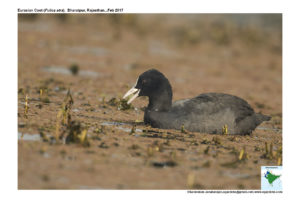Eurassian Coot

Eurasian Coot Fulica atra
Etymology:
- Fulica : Latin word for Coot
- Atra : Latin word for Black, Dark
Vernacular Names: Sind: Aari, Hindi: Dasari, Dasarni, Aari, Khuskul, Thekari, Sans: Karand kukkut, Kash: Kavput, Kolur, Kolru, Pun: Koot, Bi: Kesrar, Serar, Barra godar, Ben: Karandab, Jal kukkut, Guj: Aad, Dasadi, Bhagathadu, Kutch: Kokdi, Mar: Kaam, Poonaar, Waarkari, Namya, Chandva, Chandi, Kaarandav, Mani: Mgami porom, Porom, Ta: Naama kozhi, Te: Bolli kodi, Nalla bolli kodi, Mal: Vellakkokkan kulakkozhi, Kan: Phalaka phani, Chippugalu pakshi
Distribution in India: Resident across India
Description: Size of 36–39 cm; wt. of nominate male is 610–1200 g, wt. of female is 610–1150 g;wingspan of 70–80 cm. It is largely black except for the white and has partial webbing on its long strong toes. Both the sexes are similar. The immature is like adult but upperparts more washed with olive brown and feathers of throat, cheeks and underparts with broader white tips, giving variably mottled appearance; attains adult bare part colours between autumn and spring. The juvenile has crown, hindneck and upperparts dark brown to dark olive brown, rest of head and neck are mixed dark grey and white, flanks are olive brown, breast is whitish and belly to vent are white with grey suffusion; iris is dark grey to pale brown; bill is dusky grey, legs and feet are grey.
Habitat: It is found in still or slow-moving waters. Inhabits lakes, pools, ponds, reservoirs, barrages, gravel pits, canals, drainage channels, dykes, rivers, creeks, oxbow lakes, open marshes, flood lands and lagoons; also lakes and pools in towns, and salt-pans and clay-pans. Exploits temporary pools and seasonal marshes for breeding. Prefers fairly shallow waters with room to dive and with muddy bottom well furnished with marginal, emergent, floating or submerged vegetation
Food Habits: Omnivorous, but primarily vegetarian. Eats mainly vegetative parts and seeds of aquatic and sometimes terrestrial plants, including algae, grasses, seeds and cereals. Takes plant debris drifting on water surface. Also eats worms, leeches, molluscs, shrimps, adult and larval insects spiders, fish, fish eggs, frogs, birds and their eggs, and small mammals. Takes fish food and duck food. Employs diverse foraging method like scraping algae from hard substrates, gleaning, dabbling, upending, diving and grazing. Feeds in flocks on land, grazing near water, especially when wind causes high waves. Kleptoparasitizes. Large food items are shaken to break them up, or may be chopped up by bill on ground. Diurnal, but often active at night on moonlit nights or on floodlit waters
Breeding Habits: They breed in March–Sept. Gregarious, but monogamous, territorial and pugnacious when breeding. They are territorial all year where climate and food availability permit; pair-bonds may sometimes be retained in flocking and migratory populations. Nest in shallow water, normally in emergent vegetation but sometimes in open; normally resting on bottom or trampled foundation of vegetation, occasionally floating; artificial platforms, rafts, tree stumps, tree forks, or islands sometimes used. Receding water level can leave nest some way from water. It is made of dead and live stems and leaves, sometimes also twigs, bark and roots; nest may be built up if water level rises. Both sexes build the nest, brood platforms for family also built by male. A clutch of 6–10 eggs ; up to three replacements laid after egg loss. Incubation period is 21–26 days; incubation done by both parents; hatching asynchronous;; chicks Precocial and nidifugous; brooded on nest for 3–4 days; fed and cared for by both parents, which may divide brood temporarily or permanently; older young help feed chicks of later broods; young begin to dive at 3–5 weeks; become self-feeding at 30 days; fledging 55–60 days; fed by parents for up to two months; independent at 6–8 weeks; fly at 8–11 weeks; remain in parental territory for up to 14 weeks, possibly helping in territory defense. Age of first breeding one year. May have two broods per season.